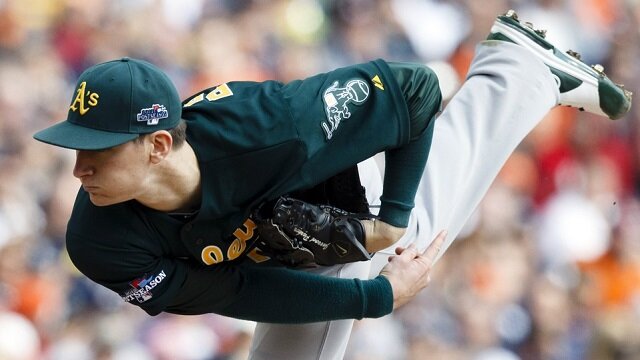San Francisco Giants Need To Be Worried About Sergio Romo
After a thrilling Opening Day win on the heels of a four-run comeback, the San Francisco Giants ought to feel like they stole a game from the division rival Arizona Diamondbacks, but Sergio Romo has suddenly become a question mark at the back end of the club’s bullpen. It would be somewhat erratic to state the Giants need to remove Romo, their closer who recorded the 27th out in 38 games in 2013, from his inherent role, but the 31-year-old veteran could be past his prime.
Romo struggled throughout Spring Training, posting a 12.38 ERA while allowing 11 hits in 8.0 innings of work. Those struggles nearly translated into a blown save on Opening Day. Diamondbacks catcher Miguel Montero crushed a lead-off solo home run off a lazy change-up to narrow Arizona’s deficit to one run in the ninth inning. In the end, Romo was able to shut the door on the D’Backs and earn the save, but it appears as though he no longer features the same bite on some of his go-to pitches as he used to.
Romo isn’t a prototypical closer in that he doesn’t showcase a blistering fastball in his repertoire. According to FanGraphs.com, Romo’s fastball tops out around 89 mph. Velocity didn’t matter in Game 4 of the 2012 World Series when Miguel Cabrera spit on a perfectly placed 89 mph fastball from Romo while sitting on a slider to crown the Giants champions. That pitch won’t be as effective this season if Romo continues to toss up batting practice change-ups and sliders to left-handed hitters, to whom he’s most vulnerable.
Throughout his career, the slider has been Romo’s signature pitch. His nasty no-dot slider has accounted for a whopping 47.3 percent of his pitches thrown in the big leagues over the course of seven seasons. “No-dot” essentially means that hitters are unable to identify the pitch as a slider when it leaves Romo’s grip. This differs from a traditional slider in that big league hitters are sometimes able to recognize the pitch as a slider because the rotation of the ball creates a white “dot” where the seams are virtually hidden.
Romo has been able to sustain success at the major league level because he’s able to effectively hide the dot on the bottom part of the ball. His slider, which averages roughly 78 mph over the course of his career, pairs well with his change-up because of the similarities in velocity. When Romo hurls a change-up toward the plate and a hitter is sitting on a slider, the pitch won’t drop off the plate, making the hitter look foolish. Romo’s change-up ranges from 80 to 82 mph. Although he doesn’t heavily rely on this pitch, he uses it to steal strikes. The fact that his change-up has become less effective is going to cause problems. In fact, it already has.
John Shea is a San Francisco Giants writer for www.RantSports.com. Follow him on Twitter @cutthroatpicks. “Like” him on Facebook or add him to your network on Google.
Assessing the SF Giants' 2015 25-Man Roster
The San Francisco Giants aren't as dangerous on paper as they were a season ago. Read More
Going Home To Blue Jays May Be What Axford Needs
It has been a long time since John Axford has been great. With a need for bullpen help, the Toronto Blue Jays should take a chance on him. Read More
Shields Would Be Best Ace Add For Cardinals
The St. Louis Cardinals are reportedly interested in adding an ace, and signing James Shields would be the best way for them to do so. Read More
Power Ranking NL Central Starting Catchers
The NL Central boasts the best catchers in all of baseball. Here is how they rank heading into the 2015 season. Read More
Tigers' Alex Avila Will Benefit From Platoon Role
Here is why Detroit Tigers catcher Alex Avila may benefit immensely from a strict platoon with James McCann in 2015. Read More
Former Players Could Haunt Royals In 2015
The Kansas City Royals made significant moves at the end of 2014, but the Chicago White Sox changed their team in a much bigger way. The Royals will now see far more of two well-liked former players. Read More
Randy Johnson's HOF Journey No Tall Tale
Will he be a Seattle Mariner or an Arizona Diamondback in the Hall of Fame? Either way, Randy Johnson's legacy will be remembered in Seattle long before it is forgotten. Read More
Keyvius Sampson Great Fit For Cincinnati Reds
The Cincinnati Reds have lost a lot of organizational depth this winter. By adding Keyvius Sampson, they have a pitcher who has the talent to quickly surprise. Read More
5 Players Phillies Need to Trade For Now
Phillies GM Ruben Amaro Jr. should be working the phones in frigid Philadelphia to warm the hearts of fans by acquiring these five rebuilding pieces. Read More
10 MLB Teams That Will Slide Backwards In 2015
Teams surprise every year, but here is a look at 10 teams that will take a step backwards in 2015. Read More
5 Players SF Giants Need to Trade For
The San Francisco Giants are seemingly prepared to enter the 2015 season without acquiring additional difference-makers this offseason. Read More
Blue Jays and Ichiro Are a Perfect Match
The Toronto Blue Jays and Ichiro Suzuki would benefit each other if they were to strike a deal. Read More









 @real_johnshea
@real_johnshea 















